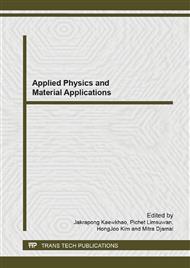[1]
S. Sindhu, S. Sanghi, A. Agarwal, V.P. Seth, N. Kishore, Effect of Bi2O3 content on the optical band gap, density and electrical conductivity of MO·Bi2O3·B2O3 (M = Ba, Sr) glasses, Mat. Che. and Phy. 90 (2005) 83-89.
DOI: 10.1016/j.matchemphys.2004.10.013
Google Scholar
[2]
X. Zhao, X. Wang, H. Lin, Z. Wang, Correlation among electronic polarizability, optical basicity and interaction parameter of Bi2O3–B2O3 glasses, Physica B: Con. Mat. 390 (2007) 293-300.
DOI: 10.1016/j.physb.2006.08.047
Google Scholar
[3]
P. Pascuta, G. Borodi, E. Culea, Influence of europium ions on structure and crystallization properties of bismuth borate glasses and glass ceramics, J. of Non-Cry. Sol. 354 (2008) 5475–5479.
DOI: 10.1016/j.jnoncrysol.2008.09.010
Google Scholar
[4]
E.M. Yoshimura, C.N. Santos, A. Ibanez, A.C. Hernandes, Thermoluminescent and optical absorption properties of neodymium doped yttrium aluminoborate and yttrium calcium borate glasses, Opt. Mat. 31 (2009) 795–799.
DOI: 10.1016/j.optmat.2008.08.004
Google Scholar
[5]
M. B. Saisudha, K. S. R. Koteswara Rao, H. L. Bhat, and J. Ramakrishna, The fluorescence of Nd3+ in lead borate and bismuth borate glasses with large stimulated emission cross section, J. Appl. Phys. 80 (1996) 4845-4853.
DOI: 10.1063/1.363520
Google Scholar
[6]
M.B Saisudha, J. Ramakrishna, Optical absorption of Nd3+, Sm3+ and Dy3+ in bismuth borate glasses with large radiative transition probabilities, Opt. Mat. 18 (2002) 403-417
DOI: 10.1016/s0925-3467(01)00181-1
Google Scholar
[7]
A. Thulasiramudu, S. Buddhudu, Optical characterization of Cu2+ ion-doped zinc lead borate glasses. J. Quant. Spec. Radiat., 97 (2006) 181-194.
DOI: 10.1016/j.jqsrt.2005.04.006
Google Scholar
[8]
A. Manal, E. Fouad, W.F. Abdel, Optical characterization of xTiO2–(60-x)SiO2–40Na2O glasses: II. Absorption edge, Fermi level, electronic polarizability and optical basicity, Opt. Com. 261 (2006) 65-70.
DOI: 10.1016/j.optcom.2005.11.056
Google Scholar
[9]
B. Eraiah, S.G. Bhat, Optical Properties of Samarium Doped Zinc-Phosphate glasses, J. Phy. Che. Sol. 68 (2009) 581-585.
DOI: 10.1016/j.jpcs.2007.01.032
Google Scholar
[10]
P. Chimalawong, J. Kaewkhao, C. Kedkaew, P. Limsuwan., Optical and Electronic Polarizability Investigation of Nd3+ Doped Soda-Lime-Silicate Glasses, J. Phy. Chem. Sol. 71 (2010) 965-970.
DOI: 10.1016/j.jpcs.2010.03.044
Google Scholar


